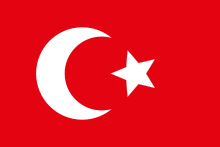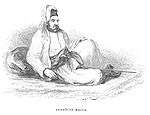Sharif of Mecca
The Sharif of Mecca (Arabic: شريف مكة, Sharīf Makkah) or Hejaz (Arabic: شريف الحجاز, Sharīf al-Ḥijāz) was the title of the leader of the Sharifate of Mecca, traditional steward of the holy cities of Mecca and Medina and the surrounding Hejaz. The term sharif means "noble" in Arabic and is used to describe the descendants of Prophet Muhammad's grandson al-Hassan ibn Ali.
The Sharif was charged with protecting the cities and their environs and ensuring the safety of pilgrims performing the Hajj. The title is sometimes spelled Sheriff or Sherif, with the latter variant used, for example, by T. E. Lawrence in Seven Pillars of Wisdom.
The office of the Sharifate of Mecca dates back to the late Abbasid era. Until 1200, the Sharifate was held by a member of the Hawashim clan,[1][2] not to be confused with the larger clan of Banu Hashim from which all Sharifs claim descent. Descendants of the Banu Hashim continued to hold the position until the 20th century on behalf of various Muslim powers including the Ayyubids and the Mamluks. In 1517, the Sharif acknowledged the supremacy of the Ottoman Caliph, but maintained a great degree of local autonomy. During the Ottoman era, the Sharifate expanded its authority northwards to include Medina, and southwards to the frontiers of 'Asir, and regularly raided Nejd.
The Sharifate came to an end shortly after the reign of Hussein bin Ali, ruled from 1908, who rebelled against the Ottoman rule during the Arab Revolt of 1916. After the defeat of the Ottoman Empire in 1918 and its subsequent dissolution in 1923, Hussein declared himself Caliph. The British granted control over the newly formed states of Iraq and Transjordan to his sons Faisal and Abdullah. In 1924, however, in the face of increasing attacks by Ibn Saud, Hussein abdicated his secular titles to his eldest son, Ali bin Hussein, who was to become the last Grand Sharif. At the end of 1925, Ibn Saud conquered the Hejaz and expelled the Hashemites. The House of Saud has ruled the holy cities and the Hajj since that time.[3]
List of Sharifs of Mecca (967–1925)
During the Fatimid Dynasty (967–1101)
- Muhammed Abu-Jafar Al-Thalab (967–980)
- Sharif Essa (980–994)
- Sharif Abu'l-Futuh (994–1012), briefly anti-Caliph in 1012
- Sharif Abu Tayeb Daoud bin Abdul Rahman bin Abi Al-Fatik (1012–1039)
- Sharif Shukrul-Din (1039–1061)
- Abul-Hashim ibn Muhammed (1061–1094)
- Ibn Abul-Hashim Al-Thalab (1094–1101)
During the Ayyubid Empire (1201–1254)

- Qatada ibn Idris al-Hasani al-Alawi (1201–1220): Killed at age 90 by his son
- Hasan ibn Qatada al-Hasani al-Alawi (1220–1241): Al-Zahir Baibers ruler of Egypt sends a prince to collect Zakat from the area including the surrounding bedouins
- Al-Hassan abul-Saad (1241–1254)
During the Mamluk Empire (1254–1517)

- Muhammed abul-Nubaj (1254–1301): First Mamluk Sharif after the fall of Ayyubid Empire
- Rumaitha Abul-Rada (1301–1346)
- Ajlan Abul-Sarjah (1346–1375)
- Sharif Ali bin Ajlan Abul-Sarjah (1375–1394): Later become Sultan of Brunei in 1425.
- Al-Hassan II (1394–1425)
- Barakat I (1425–1455)
- Malik ul-Adil ibn Muhammed ibn Barakat (1455–1473)
- Barakat II bin Muhammed (1473–1525): Built the first Walls of Jeddah by order of Al-Ashraf Qansuh al-Ghawri
During the Ottoman Empire (1517–1917)


- Barakat II bin Muhammed (1473–1525): Co-reigned with his son Abu Numayy II for the last thirteen years of his rule; first Ottoman Sharif; Hejaz became an Ottoman state after the fall of Cairo to Sultan Selim I.
- Abu Numayy II bin Barakat (1512–1584): Co-reigned with his father Barakat II for the first thirteen years of his rule, and with his son Hassan for the last thirty-one years of his rule; rebuilt the walls of Jeddah in 1525 following the victory over Portuguese Armada in the Red Sea.
- Hassan bin Abu Numayy II (1553–1601): Co-reigned with his father for the first thirty-one years of his rule.
- Abd al-Muttalib bin Hassan (1601): Reigned for less than a year.
- Abu Talib bin Hassan (1601–1603): Co-reigned with his brother Idris.
- Idris bin Hassan (1601–1620): Co-reigned with his brother Abu Talib for the first two years of his rule, then with his brother Fuhaid for six years and nephew Muhsin for sixteen.
- Fuhaid bin Hassan (1604–1610): Co-reigned with his brother Idris and his son Muhsin.
- Muhsin bin Fuhaid (1604–1628): Co-reigned with his father for the first six years of his rule, and with his uncle Idris for the first sixteen.
- Ahmed bin Abd al-Muttalib (1628–1629)
- Masoud bin Idris (1629–1630)
- Abdullah I bin Hassan (1630–1631)
- Muhammed bin Abdullah (1631–1632): Co-reigned with his first cousin once removed, Zeid.
- Zeid bin Muhsin (1631–1632): First reign, co-reigned with his first cousin once removed, Muhammed.
- Namy bin Abd al-Muttalib (1632): Briefly co-reigned with his cousin Abd al-Aziz.
- Abd al-Aziz bin Idris (1632): Briefly co-reigned with his cousin Namy.
- Zeid bin Muhsin (1632–1666): Second reign.
- Saad bin Zeid (1666–1672): First reign, co-reigned with his brother Ahmed for the last three years of his rule.
- Ahmed bin Zeid (1669–1672): First reign, co-reigned with his brother Saad.
- Barakat bin Muhammed bin Ibrahim bin Barakat bin Abu Numayy (1672–1682)
- Said bin Barakat (1682–1683)
- Ahmed bin Zeid (1672–1688): Second reign.
- Ahmed bin Ghalib bin Muhammed bin Musaid bin Masoud bin Hasan (1688–1690)
- Muhsin bin Hussein (1690–1691)
- Said bin Saad (1691): Ceded reign to his father Saad.
- Saad bin Zeid (1691–1696): Second reign.
- Abdullah II bin Hashim (1696): Co-reigned with Said.
- Saad bin Zeid (1694–1702): Third reign.
- Abdulkarim bin Muhammed (1704–1705): First reign.
- Saad bin Zeid (1705): Fourth reign, lasted eighteen days.
- Said bin Saad (1705)
- Abdulkarim bin Muhammed (1705–1711): Second reign.
- Said bin Saad (1711–1717): Second reign.
- Abdullah III bin Said (1717–1718): First reign.
- Ali bin Said (1718)
- Yahya bin Barakat (1718–1720)
- Mubarak bin Ahmad (1720–1723)
- Yahya bin Barakat (1723–1725)
- Abdullah III bin Said (1725–1731): Second reign.
- Muhammed bin Abdullah (1731–1733): Co-reigned with his uncle Masoud for the last year of his rule.
- Masoud bin Said (1732–1752): Briefly co-reigned with his nephew Muhammed for the first year of his rule.
- Musaid bin Said (1752–1759): First reign.
- Jafar bin Said (1759–1760)
- Musaid bin Said (1760–1770): Second reign.
- Abdullah IV bin Hussein bin Barakat (1770–1771)
- Ahmed bin Said (1771–1773)
- Surur bin Musaid (1773–1788)
- Abd al-Muin bin Musaid (1788): First reign, only lasted a few days.
- Ghalib bin Musaid (1788–1813): Co-reigned with his brother Abd al-Muin while Saudis held the city of Mecca.
- Abd al-Muin bin Musaid (1796–1813): Second reign, co-reigned with his brother Ghalib.
- Yahya bin Surur (1813–1827)
- Abd al-Muttalib bin Ghalib (1827): First reign.
- Muhammed bin Abd al-Muin bin Awn bin Muhsin bin Abdullah bin al-Hussain bin Abdullah I (1827–1851): First reign, placed in power by Muhammad Ali Pasha.
- Abd al-Muttalib bin Ghalib (1851–1856): Second reign.
- Muhammed bin Abd al-Muin (1856–1858): Second reign.
- Abdullah bin Muhammed (1858–1877)
- Hussein bin Muhammed (1877–1880)
- Abd al-Muttalib bin Ghalib (1880–1881): Third reign.
- Abd al-Ilah bin Muhammed (1881–1882): Was appointed again in 1908 after the deposition of Ali bin Abdullah, however he died before reaching Mecca.
- Awn ar-Rafiq bin Muhammed (1882–1905)
- Ali bin Abdullah bin Muhammed (1905–1908)
- Hussein bin Ali Pasha (1908–1916) (later King Hussein)
- Ali Haidar Pasha (1916–1917)
During the Kingdom of Hejaz (1916–1925)

- King Hussein bin Ali (1916–1924) (previously Hussein Pasha)
- King Ali bin Hussein (1924–1925)
See also
References
- ↑ "شريف مكة - ويكيبيديا، الموسوعة الحرة". Retrieved 2017-03-17.
- ↑ "الأشراف الهواشم الأمراء - أشراف الحجاز". www.al-amir.info (in Arabic). Retrieved 2017-03-17.
- ↑ "Ibn Saud reign of Hejaz – www.saudinf.com".
- ↑
- ↑ Stitt, George (1948). A Prince of Arabia, the Amir Shereef Ali Haider. George Allen & Unwin, London.
- ↑ Bosworth, Clifford Edmund (1996). The New Islamic Dynasties. Edinburgh University Press.
- ↑ Antonius, George (1946). The Arab Awakening. Capricorn Books, New York.
- ↑ The Hashemites, 1827-present